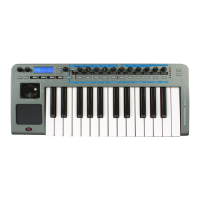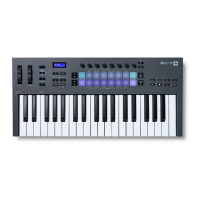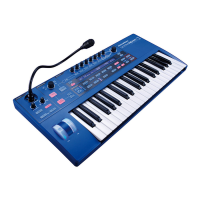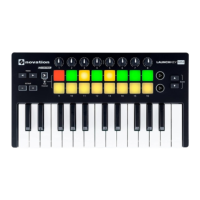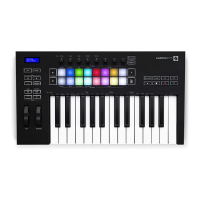Use the BOTTOM LINE knob to select the most
suitable ratio. A Simple, equal 1 to 1 ratio is the
first entry in the table. This setting sends a delay
of equal time to the left and right output chan-
nels. The number in the left column of the table
indicates the ratio of the delay time that will be in
the left channel versus the number in the right
column.
For example, if a delay of twice the time is
required in the left channel compared to the
right, select the 2/1 option. The final 1/OFF and
OFF/1 options will result in no delay being heard
in the channel indicated by the ‘OFF’.
Note: Selecting a 1/1 ratio will produce a mono
effect regardless of the Stereo width setting
since the timing of the echos are equal.
NOTE: The left / Right delay ratio will only be heard if using a Stereo
signal source.
The Reverb Effect
The Reverb Effect is an electronic simulation of a room or building that
is acoustically reflective. When a sound is made in a room or large
building, there are sound reflections from all directions. When a Reverb
effect is applied, it is these reflections of the sound that are being
added.
To adjust the controls for the Reverb effect use the UP and DOWN
arrow until the Reverb LED next the Reverb label is selected. Turn the
LEVEL knob until the Reverb effect is present.
If either the TOP LINE, or BOTTOM LINE knob is adjusted the display
will alter to display the Reverb Type and Reverb Decay as shown
below.
Rev Type: L-Hall
Rev Decay: 59
Reverb Type
Different types of rooms and halls have different acoustics, therefore
different Reverb characteristics. The Reverb processor features six dif-
ferent Reverb types. These range from a small room to a large hall.
The type are : Chamber, Small Room (S-Room), Large Room (L-
Room), Small Hall (S-Hall), Large Hall (L-Hall) and Grand Hall (G-Hall).
Turn the TOP LINE knob to experiment with different types of Reverb,
noting how different ‘rooms’ affect the acoustic properties of the sound.
Reverb Decay Time
This is the time it takes for the Reverb to die away after the original
sound has decayed. Very acoustically reflective rooms (like those with
metal or glass surfaces) tend to have long decay times and non reflec-
tive rooms have short ones. Turn the BOTTOM LINE knob to experi-
ment, lower value settings will introduce short decays and higher value
settings will create long decays.
The MENU button is non active when the Reverb option is selected
since there are no additional Reverb parameters.
The Chorus Effect
This effect was originally designed to simulate the sound of many peo-
ple singing together in unison (hence the name Chorus) in contrast to a
single voice. Instrumentally, consider the sound of a 12 string guitar
compared to a 6 string guitar. The very slight detuning of the individual
strings gives a richer quality to the sound.
Chorus is an effect produced by mixing a continuously delayed version
of the audio signal back with the original. The timing of the delayed ver-
sion is very small and is controlled by the Chorus’s own internal LFO
(not to be confused with the two LFOs available on the front panel).
The characteristic swirling Chorus effect is the result.
The Chorus is also capable of behaving as a Phaser. The way a
Phaser works is entirely different to the Chorus. A portion of the audio
signal is split off and phase shifted at certain frequencies. It is then
mixed back with the original signal to generate the characteristic swish-
ing effect.
To adjust the controls for the Chorus or Phaser effect use the UP and
DOWN arrow until the Chorus LED next the Chorus label is selected.
Turn the LEVEL knob until the Chorus effect is present.
If either the TOP LINE, or BOTTOM LINE knob is adjusted the display
will alter to display the Chorus Type and Chorus Rate as shown below.
ChorType: Chorus
Chor Rate: 25
Type
The type determines whether the Chorus is behaving as a standard
Chorus or as a Phaser unit. Turn the TOP LINE knob to switch between
Chorus and Phaser types.
Rate
The Rate controls how fast the dedicated Chorus LFO is oscillating. A
fairly slow speed is recommended. Higher speeds tend to introduce a
vibrato like quality to the sound. Turn the BOTTOM LINE knob to exper-
iment.
To access the remaining controls of the Chorus / Phaser effect proces-
sor, press the MENU button. The BANK PAGE UP/DOWN buttons may
now be used to scroll forwards and backwards through any additional
Menu screens.
Mod Depth : 95
Mod Centre : -10
Mod Depth
The Chorus has it own LFO which is continuously changing the delay
time. Mod Depth sets how much of the fixed delay time is being modu-
lated. Large amounts of modulation will produce a more noticeable
effect. Moderate amounts are recommended. Turn the TOP LINE knob
adjust the Mod Depth.
Mod Centre
The Stereo Chorus can be thought of as two continuously variable
delays. The delay variations are being controlled by the Chorus dedicat-
ed LFO. The LFO is constantly moving the two delay amounts from
minimum to maximum. When one delay is at max, the other is at min
(hence the stereo effect).
DETAILED OPERATION
The Reverb Effect - The Chorus Effect
• 24 •

